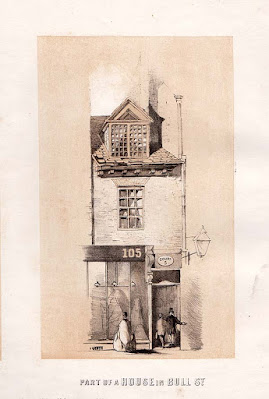Bull Street formed a junction with Colmore Row (the top part was called Monmouth Street until about 1841), Snow Hill, and Steelhouse Lane at its north end, and with Dale End and High Street at its south end. Beginning in 1878 work began on building the new Corporation Street, which cut through Bull Street and meant that part of it was knocked down.
Image below: The image below shows the entire west side of Bull Street in 1840, so around the same time as the vista, above. The top row shows numbers 109-81, and the bottom row shows numbers 80-54 (street numbers went in order at this time, not evens one side and odds the other - that was a Victorian invention).
Image below: This conjectural image, certainly produced with help of the street view of the west side (above) shows 93-93 Bull Street where the Cadbury family ran two shops. Number 93 was the tea shop which began selling a new chocolate drink during the Victorian period. Number 92 was the Cadbury drapers' shop. The scene is set in about the 1840s or 1850s.
Image above: The sign above Simpson, the fishmonger, states that it was established in 1790, and it was still going strong in this photograph from 1960. It was at 6 Bull Street, so the Georgian building to its right was 5 Bull Street.
Walk Up the West Side of Bull Street
Left to Right (109-54)
 |
| Held at Birmingham Archive. |
 |
| Bull Street from High Street, by Samuel Lines, c. 1835. Held by Birmingham Museums. |
Image above: At the corner of Bull Street and High Street was a timber framed building called the Old Lamb House (see post here), demolished in 1886 (photograph taken shortly before demolition). This shows some of the age of Bull Street. This was 108 and 109 Bull Street.
Image Below: Another old house was at 105 Bull Street. In the 1849 directory of Birmingham this was a woollen drapers' run by Whilock Smith.
 |
| 'Part of a House in Bull St', lithograph by Thomas Underwood, 1865. Taken from The Buildings of Birmingham Past and Present. |
Image below: This conjectural image, certainly produced with help of the street view of the west side (above) shows 93-93 Bull Street where the Cadbury family ran two shops. Number 93 was the tea shop which began selling a new chocolate drink during the Victorian period. Number 92 was the Cadbury drapers' shop. The scene is set in about the 1840s or 1850s.
Image Below: The photograph below shows some of the surviving Georgian houses. Depicted are numbers 81-79 with a small slice of 78 on the right. Number 81 Bull Street was being by J. Page as a mantle and shawl warehouse both in the photograph below and in the 1840 illustration above.
Walk Down the East Side of Bull Street
Left to Right (53-1)
 |
| The Quaker Meeting House with blocked up windows, sometime between 1793 and 1857. |
Quaker Meeting House was built in 1702 at the top end of Bull Street. In 1793 the site was extended and the windows at the front bricked up. A new Meeting House was built in its place in 1857, which was set well back from the street behind the frontages. Iron Room / Leaflet ?Number 40 Bull Street at the time of the 1841 vista.
 |
| Photograph by Phyllis Nicklin, 1960. |
Image above: The sign above Simpson, the fishmonger, states that it was established in 1790, and it was still going strong in this photograph from 1960. It was at 6 Bull Street, so the Georgian building to its right was 5 Bull Street.
http://epapers.bham.ac.uk/296/
Images below: At the bottom end of Bull Street where it met Dale End was a rounded building, seen in both the 1841 vista and Samuel Lines's 1835 drawing (both above). This was 1 Bull Street. In the photographs below it was run by Reece Bros as 'Ye Oldest Tobacconyst Shop in Bermyncham'. From at least 1829 to 1849 the tobacconist at number one was Joseph Smout
 |
| Bull Street, c. 1888. |





